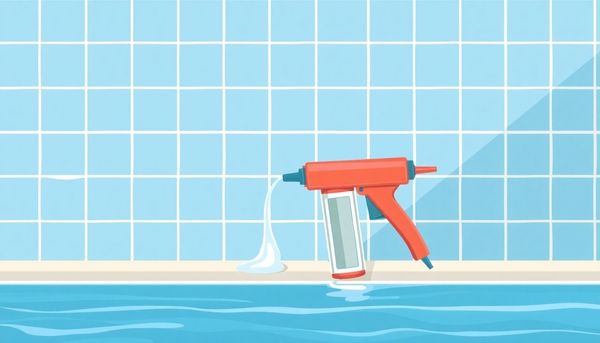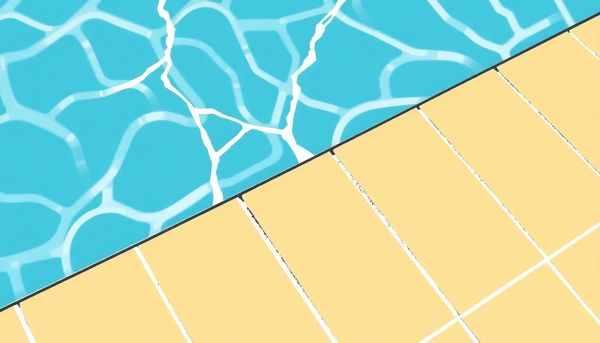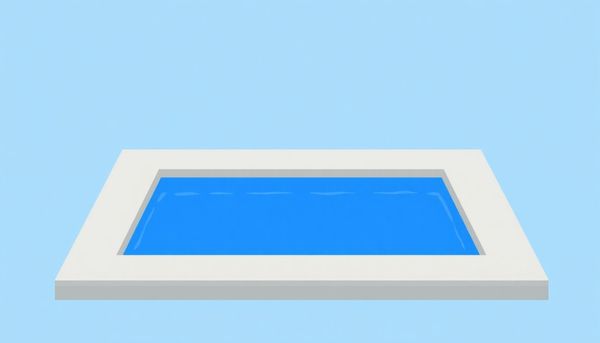Essential Guide to Pool Caulking: Protect Your Investment
March 15th, 2024
March 15th, 2024
Standing at the edge of a shimmering inground pool, you might notice the spaces where water, tiles, and decking converge—small gaps that, when ignored, can lead to bigger issues. Here, pool caulking becomes not just a maintenance task, but a crucial guardian against water intrusion. One might recall a summer afternoon when unnoticed cracks in a friend’s pool deck turned into a costly repair job after an unexpected rainstorm. These are the moments that highlight the importance of proper caulking.
For those who relish in the tranquility of their private aquatic retreat, understanding the nuances of inground pool caulking can make all the difference. It acts as a flexible sealant, safeguarding the structural integrity of your pool by preventing water from seeping into unwanted areas. It's more than just filling a gap; it's about ensuring longevity and reducing repair costs in the long run.
Swimmers and pool owners alike often overlook this unsung hero of pool maintenance. But imagine the peace of mind that comes with knowing your investment is well-protected. Not only does effective caulking offer protection, but it also enhances the overall aesthetic, providing clean lines and a well-maintained appearance. Whether you're a seasoned pool owner or newly embarking on your aquatic journey, learning to expertly apply caulking is a skill worth mastering, promising years of worry-free enjoyment.

Spotting cracks in your pool's caulking might seem trivial at first, yet these seemingly minor flaws are often precursors to larger issues. A friend of mine once learned this the hard way. She neglected her pool's caulking only to end up with a significant repair bill for structural damage later on. This experience underscores the importance of timely repair.
Begin by gathering the necessary tools: a quality caulking gun, a tube of pool-specific caulk, and some knee pads for comfort. Removing the old caulk is the first step. With a utility knife, carefully slice along the edges of the cracked caulk, then peel it away. If you're lucky, it'll come off in strips. For stubborn areas, a putty knife can be a lifesaver.
Once the surface is clear, wash away any debris with a hose and let the area dry completely. Next, load your caulking gun with the new caulk. As you apply the caulk, maintain a steady hand and a slow pace to ensure even application. Press the trigger gently and move the gun along the seam with precision. It's like icing a cake, requiring patience and attention to detail.
After applying, smooth the caulk with a wet finger or a tool specifically designed for this purpose. This helps it settle snugly into place. Allow it to cure according to the manufacturer's instructions, typically 24 to 48 hours, before exposing it to water. This small investment of effort can save you from future headaches and maintain your pool's pristine appearance.
Ever noticed those unsightly gaps glaring back at you from the pool's edge? They might seem harmless, but those cracks in your pool caulking are like open invitations for trouble. Think of caulking as the unsung hero of your pool's wellbeing, quietly standing guard against unwanted moisture. With time, however, even heroes need a little help to continue their mission effectively.
Weather changes play a sneaky role in the wear and tear of pool caulking. As temperatures swing, the structure of your pool moves slightly, expanding and contracting. This natural process can cause your caulking to crack, diminishing its ability to protect. If these cracks go unchecked, water can sneak behind the expansion joint, eventually causing costly structural issues. A friend of mine learned this lesson the hard way—what began as a small fissure turned into a hefty repair bill.
Embrace the habit of routinely inspecting the caulking. Kneeling by the pool under a warm afternoon sun, you might spot areas that appear brittle or discolored. If you're a DIY enthusiast, re-caulking can be a rewarding weekend project. Gather your tools: a sturdy caulking gun, high-quality pool caulk, and a trusty pair of gloves. A steady hand and a bit of patience will go a long way in ensuring a smooth, watertight seal. However, if the thought of handling this yourself feels daunting, enlisting professional help could be a wise investment, saving you from potential future headaches.
In maintaining your pool's caulking, you're not just preserving its aesthetic appeal; you're safeguarding its structural integrity. It's a small task with big rewards, ensuring that your pool remains a refreshing oasis free from the lurking menace of moisture damage.
There's an old saying that an ounce of prevention is worth a pound of cure, and when it comes to your pool, this couldn't be more accurate. The caulking around your pool is the unsung hero of pool maintenance. It's like the invisible gatekeeper, preventing water from sneaking into places it shouldn't, thus averting costly structural issues. Regularly inspecting and maintaining your pool caulking can avoid the financial nightmare of repairing water-damaged concrete or, worse, dealing with a shifted pool foundation.
Start by scheduling a seasonal inspection. This becomes especially crucial in regions that endure drastic temperature fluctuations. Just as your skin might dry and crack in harsh weather, so too does your pool caulking deserve some tender loving care. Look for signs of wear—cracks, gaps, or discoloration—and address them promptly with fresh caulking. A personal ritual I adopted was to combine this task with the changing of seasons, ensuring it didn’t slip through the cracks of a busy schedule.
Moreover, investing in quality materials can make all the difference. High-grade caulking may cost a bit more initially, but it pays dividends in extended longevity and effectiveness. If you're not confident in tackling this task solo, enlisting professional help can be a wise investment. Remember, the key is proactive care; a small effort now can save immense headaches later, keeping your pool a pristine oasis for years to come.
Approaching the task of caulking your pool might seem daunting, but it’s more about patience and precision than anything else. Begin by choosing a sunny day, as dry conditions are your allies. The first step is to thoroughly clean the expansion joint. Any debris or old caulk remnants can prevent the new caulk from adhering properly. Armed with a utility knife and a soft brush, take your time to ensure that every last bit of the old material is removed.
With the joint prepped, it's time to apply the caulk. A caulking gun is your trusty companion here. Holding it at a steady 45-degree angle, gently squeeze the trigger and guide a consistent bead of caulk along the joint. It helps to keep a slow and steady pace; rushing can lead to uneven application. If you recall the last time you tried icing a cake, the technique is surprisingly similar, requiring a delicate touch to create a smooth surface.
Once the caulk is in place, use a caulk finishing tool or your finger—dipped in soapy water for a smooth glide—to press the caulk deeper into the joint, ensuring it fills every crevice. This is crucial for preventing water ingress. Allow the caulk to cure completely before exposing it to water or foot traffic, which typically takes about 24 to 48 hours. The patience you invest now will reward you with a pool that stands proud against the elements, both in function and in form.

Maintaining the caulk around your inground pool is akin to keeping the roof over your home watertight. A tiny oversight can cascade into significant headaches. Pool caulking acts as a protective barrier, preventing water from seeping into areas where it can wreak havoc. If you've ever had to deal with a leaky window seal, you’ll understand how moisture, when given even the slightest opportunity, can infiltrate and create chaos, much like an uninvited guest overstaying their welcome.
Over time, pool caulking can become brittle, succumbing to the natural wear and tear inflicted by shifting temperatures and the relentless play of the sun. This is where the expansion joint comes into play, a silent hero that absorbs the stress of your pool’s concrete frame as it expands and contracts with the weather. Yet, without proper caulking, this essential feature can falter, allowing moisture to penetrate and eventually cause structural damage.
I once spent a summer afternoon re-caulking my own pool, a task I approached with caution and a healthy respect for the potential consequences of any mistakes. Armed with a caulking gun and a plan, I learned the importance of patience and precision. Each bead of caulk was carefully applied, ensuring it met perfectly at the edges, sealing every potential entry point for water. It was a painstaking process, but knowing that this preventative measure could save me from costly repairs provided all the motivation I needed.
In essence, maintaining your pool’s caulking is both an art and a science, one that requires attention but rewards you with peace of mind. As tedious as it might seem, re-caulking is a straightforward, worthwhile endeavor to safeguard your pool’s longevity and beauty.
The sun-drenched afternoons by the pool might seem flawless, but hidden beneath those shimmering waters, a potential problem could be brewing. Pool caulking, although often overlooked, plays a crucial role in maintaining the integrity of your inground oasis. The sight of cracked or missing caulking isn't just an eyesore—it's a warning sign of potential hazards waiting to manifest.
First, let's talk visibility. Any visible cracks or gaps in the caulking are immediate indicators that the material has lost its elasticity. This happens due to the natural wear and tear from sun exposure, fluctuating temperatures, and the inevitable expansion and contraction of the pool structure. When observing these signs, think of it as your pool’s way of communicating a need for a little TLC.
Another telltale sign is moisture. Notice any dampness or water gathering near the joints? This could suggest that the protective barrier has been compromised. Water seeping into these cracks can lead to more severe structural issues over time, as moisture infiltrates areas it was never meant to reach.
Feeling handy? Before rushing to replace the caulk, ensure you understand the scope of the task. It's not merely about patching up; it's about restoring a vital line of defense for your pool. However, if the project feels daunting, calling in a professional might save you headaches—and potential wallet-aches—down the line. Keep your pool in tip-top shape, and those summer days will remain as carefree as ever.
Recognizing the need for quality caulking products for your pool is akin to ensuring you have the right ingredients for a recipe; the end result depends heavily on what you start with. Not all caulks are created equal, and the wrong choice could leave you with more than just a cosmetic issue. Choose caulk specifically designed for pool use, as it needs to withstand constant exposure to water, fluctuating temperatures, and UV rays.
Once, while helping a friend with his pool, we discovered that the generic caulk he had used was peeling off in chunks. It was a lesson learned the hard way: always opt for silicone-based or polyurethane-based caulks, which offer superior flexibility and durability. These materials are tailored to endure the unique demands of a pool environment.
Additionally, consider the color of the caulk. Some might think it's purely aesthetic, but the right shade can blend seamlessly with your pool, enhancing rather than detracting from its appearance. When selecting your product, read reviews, check manufacturer recommendations, and, if possible, consult with pool maintenance professionals.
By investing in top-notch caulk, you’re not just maintaining your pool’s looks; you’re safeguarding its structural integrity. This simple act of choosing quality over cost can save you from costly repairs and headaches in the future. So, next time you're at the store or browsing online, remember that the right caulk is an ally in your pool’s longevity.
A sunlit afternoon by the pool is a dream for many, but cracked caulking can swiftly turn this dream into a costly nightmare. Recognizing the importance of professional intervention can be the difference between a well-maintained oasis and a spiraling maintenance disaster.
Consider my neighbor, Jim, whose DIY enthusiasm often leads to weekend projects. When his pool’s caulking began to crumble, he confidently took matters into his own hands. However, a small oversight meant water seeped into the expansion joint, leading to a hefty repair bill when the tiles began to lift and crack. This tale serves as a gentle reminder that sometimes, calling in an expert is the wiser choice.
Opting for a professional caulker brings peace of mind. These seasoned experts understand the intricacies of how weather affects pool structures. They can swiftly identify problem areas that might escape the untrained eye, ensuring every seam is sealed to perfection. Not only does this approach protect your investment, but it also enhances the aesthetic appeal of your pool, making it look as pristine as the day it was installed.
In summary, while DIY projects have their charm, entrusting your pool caulking to a professional can save you time, effort, and potential future expenses. It's an investment in preserving the beauty and structural integrity of your pool for years to come.

When it comes to your beloved swimming pool, the unsung hero is often the caulking around the expansion joints. This seemingly minor detail plays a crucial role in maintaining your pool's integrity. Think of it as the pool's protective shield, keeping unwanted moisture at bay and ensuring the structure remains sound. My friend once overlooked this maintenance task, only to face a hefty repair bill when creeping moisture caused unexpected damage.
Expansion joints are essential for concrete pools, allowing them to flex with temperature changes without cracking. These joints need a reliable caulk seal to keep water from sneaking in. It's like putting a raincoat on your pool, guarding against the elements. When the caulk gets tired and crumbly, it’s time for a refresh. Check the seal regularly, especially if your pool braves drastic seasonal shifts.
For those feeling adventurous and handy, re-sealing the joints can be a satisfying DIY project. Arm yourself with a caulking gun, some fresh sealant, and perhaps a knee pad—your joints will thank you after a few hours spent crouched by the poolside. Start with clean surfaces, ensuring the new caulk adheres properly. Apply with precision, smoothing it evenly for a neat finish. A steady hand here could save you significant costs in repairs later.
Don't underestimate this task. Properly sealed expansion joints are a small investment of your time that can yield big rewards, safeguarding your pool from potential hazards. Consider it an act of loving maintenance, keeping your summer oasis in perfect condition for many seasons to come.
Do you recall that moment of pride when you first saw your pristine pool, the water shimmering under the sun? That sparkle can quickly dull if you overlook the small yet significant detail of pool caulking. Caulking serves as the hidden hero, safeguarding your pool against unwanted moisture that could sneak behind the scenes and wreak havoc. Identifying cracks or damage early is crucial. Even the tiniest fissure can invite trouble, leading to costly repairs if left unchecked.
Vigilance is your ally when it comes to maintaining the integrity of your pool’s caulking. Periodically inspect the caulk for signs of aging or brittleness. Weather changes, no matter how subtle, can lead to expansion and contraction of the pool materials, weakening the caulk over time. This natural wear and tear might not catch your eye immediately, but it’s worth a closer look. A small crack today can pave the way for water infiltration tomorrow, compromising the structure of your pool.
Take a leisurely walk around your pool, paying close attention to the expansion joints where concrete meets the pool lining. These areas are particularly prone to damage. While some might consider this inspection tedious, imagine the peace of mind knowing your pool remains in top condition, ready for endless summer enjoyment. If the task seems daunting, it might be wise to consult a professional. A little proactive care today ensures your pool will continue to be a source of joy, not a cause for concern.
Kicking off a caulking project for your inground pool requires more than just a tube of sealant and an afternoon to spare. First things first, gather your toolkit: a caulking gun, a sharp utility knife, a sturdy scraper, and a roll of masking tape. A leaf blower is an unsung hero here, too, clearing away debris that might compromise your work. Next, inspect the weather forecast. A dry, mild day is ideal because caulk doesn't adhere well when moisture lingers or the temperature swings too drastically.
Preparation isn't just about tools and timing; it's about setting the scene for success. Spend a few minutes inspecting the current state of your pool’s expansion joints. Look for any stubborn dirt or old caulk clinging to the edges. Removing this old material isn't glamorous, but it's crucial for ensuring the new caulk bonds properly. If you spot algae or grime, a little elbow grease with a pool-safe cleaner will do wonders. Remember, patience here saves headaches later.
Consider your comfort, too. Kneeling pads or an old cushion can be a lifesaver for your knees during this task. Additionally, plotting out your work plan in advance can help you navigate the project with ease. Decide whether you'll tackle the job solo or enlist a helper. Having an extra set of hands can streamline the process, making it more efficient and—dare I say—enjoyable. With everything in place, you're ready to transform those pool edges from eyesores to assets.
Applying caulk evenly around your pool is more than just a maintenance task; it’s an art form that requires patience and precision. Think of it like frosting a cake, where the goal is a smooth, flawless finish that not only looks good but serves a protective purpose. Starting with clean surfaces is essential. Ensure all old caulk is removed, and the areas are free of dirt or debris. A little time spent here saves trouble later.
Using a quality caulking gun can make a world of difference. A steady hand and a consistent pace are your best friends. The trick lies in applying even pressure as you move along the expansion joint. You might find it helpful to practice on a scrap piece of material if you’re feeling rusty. It’s akin to learning how to write with your non-dominant hand—awkward at first, but it soon becomes second nature.
If you’re working in an area with a view of the street, consider how the caulk line will look to passersby. This isn’t just about water tightness; it’s about curb appeal too. A damp sponge or a finger dipped in soapy water can help smooth out the line, ensuring that the caulk adheres properly and fills every gap.
Finally, assess your work with a critical eye. Check for gaps or uneven spots once the caulk has dried. Filling these in promptly prevents problems down the road. With each stroke, you’re not just maintaining a pool; you’re safeguarding an investment and enhancing an outdoor oasis.

There's something oddly satisfying about the sight of a pristine pool edge, free from cracks and blemishes. Yet, beneath that surface beauty lies a functional hero often overlooked—pool caulking. Acting as a protective barrier, the caulk keeps water from seeping into areas where it can cause unseen damage. When it starts showing signs of wear, it’s not merely an aesthetic issue; it’s a warning signal.
In my own backyard, I discovered the importance of timely caulk replacement after a particularly harsh winter. The once sturdy caulking had become brittle, and small cracks began to emerge, threatening the structural integrity of my pool. Ignoring such signs can lead to water infiltration, resulting in costly repairs as moisture freezes and expands, wreaking havoc on the underlying structure.
Replacing old caulking promptly is crucial, especially in climates with fluctuating temperatures. Each shift from heat to cold causes expansion and contraction, pushing the boundaries of your pool’s materials. By addressing caulk deterioration at onset, you prevent moisture from sneaking in and causing damage that could far exceed the cost of a simple weekend project.
For those with a penchant for DIY, replacing pool caulk can be rewarding. Armed with a caulking gun and a sunny afternoon, you can restore the seal that safeguards your pool. However, if you’re unsure, hiring a professional may save you from headaches—and future wallet aches. In any case, remember: a stitch in time saves nine, and in this scenario, perhaps thousands.
A stroll around your pool might reveal tiny fissures or even small holes creeping into your once-pristine caulking. These imperfections may seem minor, yet they hold the potential to unleash a cascade of complications. Pool caulking is not merely a decorative touch but a crucial barrier protecting your pool's structural integrity. It acts like the seal around a submarine hatch, keeping unwanted water from seeping into vulnerable areas.
Spotting these cracks early can be your saving grace. Begin with a meticulous inspection, running your fingers gently along the expansion joints—the areas most susceptible to damage. On a sunny afternoon, sunlight can help illuminate any crevices you might otherwise miss. Remember, weather takes its toll on caulking. As seasons shift, temperature fluctuations cause your pool to expand and contract, straining the caulking. This relentless cycle can compromise even the most robust materials over time.
I recall the time when my uncle, an ardent DIY enthusiast, took on the task of re-caulking his backyard oasis. Armed with patience and precision, he managed to avert potential disaster. Similarly, your vigilance in identifying and addressing these issues can prevent severe structural damage and costly repairs. A little effort in maintenance today ensures your pool remains a haven of relaxation tomorrow, free of lurking hazards. Be proactive, and your pool will reward you with years of uninterrupted enjoyment.
Caulking an inground pool is more than a cosmetic touch-up; it’s your frontline defense against moisture intrusion. In older homes, I learned the hard way that ignoring brittle or cracked caulk can lead to water seeping into unwanted areas, slowly wreaking havoc before you even notice. My uncle's pool, for instance, once developed a tiny crack in the caulking. He brushed it off at first, thinking it was merely an aesthetic issue. Months later, he found himself facing a hefty repair bill, as water had seeped behind the tiles, causing structural damage.
The pool caulk’s role is akin to a vigilant guard—ever-present and silently protecting. It seals expansion joints, which are critical in allowing your pool's structure to flex with temperature changes. Without effective caulking, water could easily creep into these joints, expanding and contracting with the weather, and ultimately causing significant damage. This is particularly true in regions with drastic seasonal shifts, where the freeze-thaw cycle can be particularly unforgiving.
Replacing worn-out caulk isn’t just a seasonal chore; it’s an act of preservation. Whether you tackle this as a weekend DIY project or call in a professional, ensure it’s done with precision. A well-sealed pool not only functions optimally but also saves you the heartache and financial strain of avoidable repairs. Remember, it’s often the smallest cracks that lead to the largest headaches.
Unaware of the subtle dance between water and caulk, many pool owners find themselves overwhelmed when issues arise. It's at such times that an expert's touch becomes invaluable. Consulting a professional for pool caulking isn’t just for those who lack the time or skill; it’s also for those who want peace of mind. Professionals carry years of experience and nuanced understanding of the materials and techniques involved.
Think about it this way: just as you would trust a mechanic with your car’s engine or a dentist with your teeth, a pool specialist brings insight that’s hard to match. They can diagnose not just the obvious cracks, but also the potential weak spots that might escape an untrained eye. This foresight can be particularly essential in regions with harsh weather fluctuations where the risk of structural damage looms larger.
Moreover, a professional not only ensures a flawless application but does so with efficiency, minimizing downtime for your pool. They will have access to commercial-grade materials that might last longer than those available at your local hardware store. If you’ve ever spent a weekend laboring over a DIY project only to have it undone by lack of experience, you’ll appreciate the value of an expert's touch.
In the grand scheme of pool maintenance, hiring a professional for caulking isn’t just about getting the job done—it’s an investment in the health and longevity of your pool.

Pool maintenance often feels like a never-ending saga of tasks, each with its own importance. Among these, maintaining the structural integrity of your pool with proper caulking might just be the unsung hero. In the intricate dance of pool upkeep, caulking acts as the defensive barrier, warding off water from infiltrating the expansion joints. A friend of mine once neglected this simple step, dismissing the small cracks as mere cosmetic blemishes, only to end up with a repair bill that could have bought a small vacation.
The process to safeguard your pool begins with inspection. Spotting signs of wear, such as brittle or discolored caulk, should raise an immediate red flag. It's not just about appearances; these cracks are gateways for water, which can wreak havoc as temperatures fluctuate. Remember, water is a persistent intruder, capable of expanding and contracting with the weather, putting enough pressure on those joints to cause serious damage.
Embarking on the caulking mission yourself requires a blend of patience and precision. Tools at the ready, clear the area of debris, and ensure the surface is dry for optimal adhesion. The application should be seamless, filling every crevice. And while the task demands time on your knees, the result—a well-sealed pool—is worth the effort. For those less inclined to DIY, professional help ensures peace of mind. Ultimately, this small but crucial action fortifies your pool against costly repairs, preserving both its beauty and functionality for many summers to come.
During a summer gathering, I once noticed the unsightly cracks lining my friend's pool, and it wasn't just an aesthetic issue. Pool caulking plays a vital role in preserving the integrity of the structure. These small gaps can lead to big problems if left unattended, as they allow moisture to infiltrate places it shouldn't. Over time, this daunting infiltration can swell and shrink with temperature changes, wreaking havoc on your pool's foundation.
Regular inspection of your pool's caulking is as essential as checking your car's oil. At least once a season, take a leisurely stroll around the pool, examining the caulking for any signs of aging or damage. Weather and time are relentless, and even the sturdiest caulk can weaken, causing expansion joints to become vulnerable. These joints are designed to handle the natural movement of your pool but are rendered ineffective if not properly sealed.
When repair becomes inevitable, approach it with care. Start by meticulously removing the old caulk, ensuring no debris remains. Clean the area thoroughly, as any dirt can compromise the new seal. Equipped with a fresh tube of quality sealant, slowly fill the joint, taking care to smooth it evenly. This might require patience, but if done correctly, it will save you from future headaches.
For those less inclined to DIY, hiring a professional may be wise. Although it requires an upfront investment, this precautionary measure is far more economical than the costly repairs that unchecked water damage can bring. Prioritizing pool caulking preservation ensures that your summer oasis remains safe and stunning for years to come.

This article provided insights into maintaining your pool. Start your pool care journey today!
Want to become a pool maintenance expert? Our free Pool School course covers everything you need to know about pool care. From basic maintenance to advanced troubleshooting, you'll learn how to:
Join over 10,000 pool owners who have already transformed their pool care routine. Get started with our free Pool School course today!